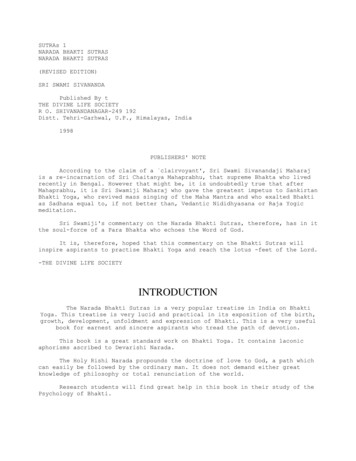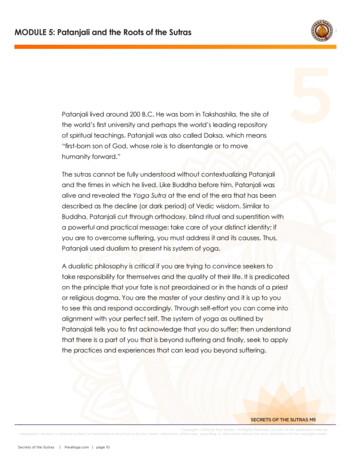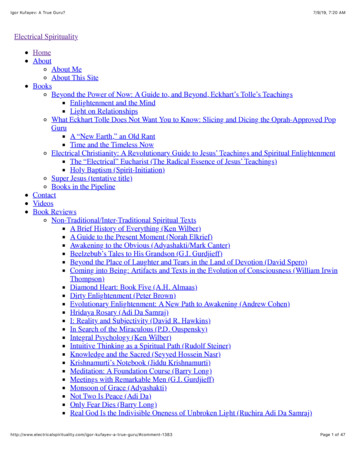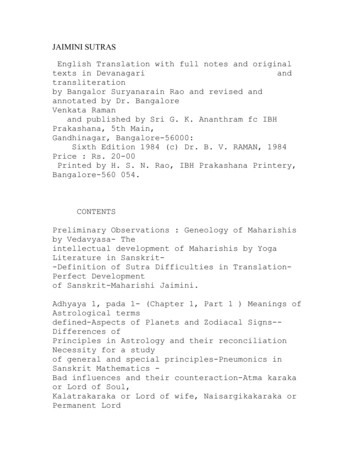
Transcription
ParaYoga Master TrainingSecrets of the Sutras: Light on Self MasteryCopyright 2015 by Rod Stryker, All Rights ReservedNo part of this publication may be reproduced, stored in a retrieval system, or transmitted in any form or by any means (electronic, photocopy, recording, or otherwise) without the prior premission of the copyright owner.
Secret of the Sutras: Table of ContentsMODULES 1 & 2: Yoga Sutra–The Preeminent Teaching on Yoga.1MODULE 3: The Foundations of Asana (Sutras 2:46 - 2:48).5MODULE 4: Yoga Sutra: The Full Spectrum of Practice.7Karma Chakra.9MODULE 5: Patanjali and the Roots of the Sutras. 10Timeline of the Vedas, Sutra and Tantra. 12Invocation to Patanjali. 13MODULE 6: Practice, It’s All About Practice (Sutras 1:1 - 1:11). 14MODULE 7: The Two-Fold Path to Spiritual Mastery (Sutras 1:12 - 1:16). 16MODULE 8: The Path to Samadhi (Sutras 1:17 - 1:22).18MODULE 9: The Path to Samadhi (Sutras 1:17 - 1:22). 20Model of the Mind: Antahkarana - Inner Instrument. 23MODULE 10: On Mastering Asana (Sutra 2:47). 24MODULE 11: Ishwara–The Highest Truth (Sutras 1:23 - 1:33). 25MODULE 12: Gateway to the Luminous (Sutras 1:34 - 1:41). 30Anatomy of Prachardana. 33MODULE 13: Samadhi and the Stages of Revelation (Sutras 1:42 - 1:51). 34MODULE 14: Kriya Yoga: The Action of Yoga (Sutras 2:1 - 2:2). 38MODULE 15: The Anatomy of Suffering (Sutras 2:3 - 2:14). 40MODULE 16: Towards a Joyous and Luminous Future (Sutras 2:15 - 2:16). 46MODULE 16: Towards a Joyous and Luminous Future (Sutras 2:15 - 2:16). 50MODULE 17: Ultimate Fulfillment and Freedom (Sutras 2:17 - 2:19). 52SECRETS OF THE SUTRASCopyright 2016 by Rod Stryker, All Rights Reserved. No part of this publication may bereproduced, stored in a retrieval system, or transmitted in any form or by any means (electronic, photocopy, recording, or otherwise) without the prior premission of the copyright owner.
MODULE 18: Cave of the Heart Meditation (Sutra 1:36). 54MODULE 19: More on Avoiding Pain (Sutras 2:20 - 2:27).59MODULE 20: The Great Disciplines: Ashtanga Yoga (Sutras 2:28 - 2:55).61Designing A Personal Practice: Based on Vinyasa Krama, Tantra Shaktiand Secrets of the Sutras. 63MODULE 21: Higher Consciousness Dawns (Sutras 3:1 - 3:7, 3:16 - 3:50).67MODULE 22: Into the Height of Yogic Powers (Sutras 3:16 - 3:50).71MODULE 23: Designing a Personal Practice. 73MODULE 24: Going Forward: Anchored to the Treasures of Yoga. 75Technique Compendium. 76Final Assignent. 79Reflections on Practice Survey. 83GlossarySECRETS OF THE SUTRASCopyright 2016 by Rod Stryker, All Rights Reserved. No part of this publication may bereproduced, stored in a retrieval system, or transmitted in any form or by any means (electronic, photocopy, recording, or otherwise) without the prior premission of the copyright owner.
MODULES 1 & 2: Yoga Sutra–The Preeminent Teaching on Yoga1Yoga Sutra comprises the core of the yoga tradition’s approach tocomplete mastery of the mind. Its aim is to lead you to lasting freedomand fulfillment through the gateway of self- knowledge.Two fundamental concepts shape your perception––Momentum andContent. The Tantra Shakti and Vinyasa Krama trainings focused onMomentum. By incorporating, among other things, dosha, vayu, bandha,pranayama and mudra, you experienced the power of momentum toshape your experience. Through theory and practice, you learned thatskillfully affecting momentum can positively impact your mind, capacityand even physical wellbeing. This approach could be summed up as“change your energy, change your life.”The Yoga Sutra marks a shift. While there are sections of the scripture thatfocus on Momentum (i.e. the sutras on pranayama), the heart of thetext––and its emphasis for creating positive change––is based on shapingContent, aiming to directly affect the constituents of mind and the field ofall experience, conscious as well as unconscious. From the point of view ofthe sutras, you have two kinds of Content: innate and acquired.In simple terms, your innate content refers to the pristine essential naturewith which you came into this life; acquired content is the mind stuff youwill collect through the course of your life. Your innate content is an islandof self-luminosity, innately Divine. It is the light of consciousness, identicalto that essence from which all things are born and by which all thingsare sustained.SECRETS OF THE SUTRAS M1 & M2Copyright 2016 by Rod Stryker, All Rights Reserved. No part of this publication may bereproduced, stored in a retrieval system, or transmitted in any form or by any means (electronic, photocopy, recording, or otherwise) without the prior premission of the copyright owner.Secrets of the Sutras ParaYoga.com page 1
However, the teachings of samhkya and the Yoga Sutra make it clear thatbecause you identify with your acquired content (i.e. memory, belief, pastimpressions, expectations and attachments), you fail to see your essential1nature (your innate content). Furthermore, your acquired content blinds yourability to recognize your most fundamental misperceptions, including thevery fact that you are identified with your acquired content, not yourinnate content.However, the most fundamental factor obstructing the mental clarity andtranquility necessary to reach the highest freedom and fulfillment is that yourmind is constantly spinning (vritti).Whether you think pleasant thoughts or less than pleasant thoughts, whetheryour mind is confused or is able to rationalize and infer correctly, the mind’sendless tendency to spin prevents you from experiencing the luminous joythat is your innate content. Learning to stop the endless pattern of spinningis the key to unlocking the state of yoga. Indeed, achieving this is the verydefinition of yoga: “complete mastery of the roaming tendencies of themind is yoga” (sutra 1:2 “yogas citta vritti nirodha”).Patanjali offers the yoga tradition and its systematic approach to teach youhow to get past the limits and prejudices of your acquired content, in orderfor you to abide in your innate content––the shining light of excellence thatis your soul.Achieving ultimate freedom, lasting happiness and the realization of yourtrue nature, is all but impossible if you continue to remain identified withyour acquired content. It is this misapprehension (avidya) that is the basis ofsuffering––dukham. For those wanting to break the cycle of pain andsuffering, for those interested in solving this existential challenge, Patanjalioffers the Yoga Sutra––a methodical approach to viyoga (separation)from your acquired content.SECRETS OF THE SUTRAS M1 & M2Copyright 2016 by Rod Stryker, All Rights Reserved. No part of this publication may bereproduced, stored in a retrieval system, or transmitted in any form or by any means (electronic, photocopy, recording, or otherwise) without the prior premission of the copyright owner.Secrets of the Sutras ParaYoga.com page 2
Our approach to the scripture is as a guide to practice, specifically howpractice most profoundly affects perception. This orientation is consistent1with the “Moon” of the three stages of Moon, Sun and Fire. The Yoga Sutrateaches you to engrain the habit of attaining and maintaining a peacefuland steady flow of mind. It is the systematic approach to stop theroaming/spinning tendencies of the mind.The word sutra refers to a terse or pithy statement, one that is steepedin “su” (goodness). Also, like a “suture,” the Sutra acts as a thread linkingtogether all the previous teachings and thereby offering you theopportunity to suture together the gaps in your consciousness.Yoga Sutra is systematic, consisting of 196 statements in 4 Chapters:lSamadhi Pada 1 – yoga and its goallSadhana Pada 2 – the practice of yogalVibhooti Pada 3 – the powers, siddhis and capacitiesthat arise out of the practiceKaivalya Pada 4 – the goal of yoga – kaivalyalSutras 1:19 and 1:20 describe the qualities of samadhi (stages leading toenlightenment). They are very revealing, because they help you to see thepractical nature and value of perfecting your mind. Samprajnata(partial) samadhi and asamprajanata (complete) samadhi describe thestate where you have full understanding of the objects of your choosing. Insamprajnata, you will have a full understanding of some “thing” (this objectcan be material, mental, subtle or even sublime), whereas asamprajnatasamadhi refers to the highest realization, allowing you to perceive beyondall limitations, to have complete understanding of everything––in otherSECRETS OF THE SUTRAS M1 & M2Copyright 2016 by Rod Stryker, All Rights Reserved. No part of this publication may bereproduced, stored in a retrieval system, or transmitted in any form or by any means (electronic, photocopy, recording, or otherwise) without the prior premission of the copyright owner.Secrets of the Sutras ParaYoga.com page 3
words, enlightenment. Thus the two stages of samprajnata andasamprajnata refer to either merging with a chosen object or idealor transcending all objects (asamprajnata).Patanjali then provides guidance, telling us that five specific virtues mustbe cultivated until you reach asamprajnata. This also suggests that onceyou are enlightened, you will embody these five virtues completely and1perfectly. They are:lshraddha: faithlvirya: will, potencylsmrti: retentive powerlsamadhi: absorptionlprajna: illuminative wisdomSECRETS OF THE SUTRAS M1 & M2Copyright 2016 by Rod Stryker, All Rights Reserved. No part of this publication may bereproduced, stored in a retrieval system, or transmitted in any form or by any means (electronic, photocopy, recording, or otherwise) without the prior premission of the copyright owner.Secrets of the Sutras ParaYoga.com page 4
MODULE 3: The Foundations of Asana (Sutras 2:46 - 2:48)Of the text’s 196 sutras, Patanjali addresses the subject of asana in onlyfour (all of which are found in Chapter 2, Yoga and Its Practice). Despitethe brevity of the teachings on asana, the four “asana sutras” are a3profound rendering of the role of asana and how its practice relates tothe ultimate intent for realizing the state of yoga. The word asana firstappears in Chapter 2 (2:29), where it is simply listed as one of the eight limbs.It is not until 2:46 – 2:48 that asana practice is presented in three principles:one, how to practice asana two, how to master asana and three, the signsthat you have mastered asana.For most modern practitioners, asana is commonly practiced primarilyas a tool to accomplish asana. Patanjali’s teachings offer this approach:the sole focus is on asana as a tool to master the mind.The first principle of asana, according to Patanjali, is that it must bepracticed with ease (sukham) and steadiness (sthiram): not forcing yourselfinto a pose for the sake of mastering it. From the view of the yoga tradition,asana is not a means for accomplishing anything other than the realizationof complete ease and steadiness. The next teaching on asana presentsthe key to mastering it: “loosen effort, while meditating on the Infinite.”Following this, we find the final principle––the result of mastering asana,specifically: “The pairs of opposite cease to have impact.”The ultimate achievement of asana practice is that you are no longeraffected by changing circumstances; life’s constant swing from goodto bad, light to dark, success to failure, etc. no longer conditions yourexperience. You are the embodiment of centeredness and stabilityin the midst of change; you are at peace in the midst of uncertainty.SECRETS OF THE SUTRAS M3Copyright 2016 by Rod Stryker, All Rights Reserved. No part of this publication may bereproduced, stored in a retrieval system, or transmitted in any form or by any means (electronic, photocopy, recording, or otherwise) without the prior premission of the copyright owner.Secrets of the Sutras ParaYoga.com page 5
To achieve this, you will need to practice systematically.In the Tantra Shakti training, we covered the lunar (chandra)approach to practice: fewer poses, 1:1 breathing and developing“witness consciousness.” When applied consistently, this approachestablishes a safe harbor for the mind and a deep sense oftranquility; it slowly teaches you to internalize attention and setsthe stage for non-attachment or self-surrender.3The point is that Patanjali has made it clear what you are meant to achievethrough asana practice. In short, the most meaningful sign of progress inasana is that you are more stable, more at ease and less distracted; youare consistently aware of the higher meaning and purpose of your life.SECRETS OF THE SUTRAS M3Copyright 2016 by Rod Stryker, All Rights Reserved. No part of this publication may bereproduced, stored in a retrieval system, or transmitted in any form or by any means (electronic, photocopy, recording, or otherwise) without the prior premission of the copyright owner.Secrets of the Sutras ParaYoga.com page 6
MODULE 4: Yoga Sutra: The Full Spectrum of PracticeYoga Sutra is a road map for reaching the heights of human capacity––directly experiencing one’s divine nature. While the text can be studied4from many different approaches, there is only one way to arrive at the finaldestination and fulfill the promise of its teachings: practice. Its essence andthe powerful truths that fill this scripture can never be fully understood orrealized unless it is treated as a practice manual.The entire spectrum of yoga practice is outlined in its pages. The great sagePatanjali gathered and organized, with absolutely perfect clarity andsublime insight, all previous systems of Vedic knowledge, including Vedanta,Tantra, Veda, Buddhism, and Jainism. The teaching of the Yoga Sutra is sofar-reaching that it would eventually become known as yoga shastra, thefinal authority on yoga philosophy and practice.From the viewpoint of the Sri Vidya tradition, the three systems of yoga,Vedanta and Tantra, along with Samkhya (yoga’s philosophical background) are part of a single, comprehensive, sublime science. In fact, onecan find all three spiritual systems throughout the text. Thus, rather thanapproaching these systems as separate and seeing the teachings of theYoga Sutra as distinct from the other systems, our approach will integrateyoga, Vedanta and Tantra and apply them as a continuum. This approachincorporates all three systems and breathes the full force and wisdom ofPantanjali’s gift to all seekers wishing to overcome the darkness that coverstheir mind and heart. The Yoga Sutra is a path, leading to everlasting andself-luminous joy.Instead of trying to achieve happiness and freedom by mastering theexternal world, the Yoga Sutra asks you to master your mind and gainSECRETS OF THE SUTRAS M4Copyright 2016 by Rod Stryker, All Rights Reserved. No part of this publication may bereproduced, stored in a retrieval system, or transmitted in any form or by any means (electronic, photocopy, recording, or otherwise) without the prior premission of the copyright owner.Secrets of the Sutras ParaYoga.com page 7
access to its innate power and intelligence. Only through mastery of themind can eternal freedom be yours. To see yourself as you really are,you must restore the pristine nature of mind, clear the karmic impuritiesand allow your mind’s innate luminosity to shine.The timeless sage, Vyasa provided the text’s greatest commentaryfour centuries after Patanjali revealed it. Vyasa’s commentary is vital4in order to understand and apply its teachings, particularly themethodologies that are referenced in its pages. The terse nature of theYoga Sutra limited what Patanjali could include, in as much as he assumedthat it would be studied under the guidance of a master. He offers theuninitiated seeker little to nothing in the way of practical detail––i.e. he’lldescribe a practice, but only the bare minimum about how to do thepractice. A teacher would be required to guide the student into thespecifics of the practice. Vyasa’s commentary serves to fill in these gapsand provides the living wisdom necessary to apply and embody the sutras.From the viewpoint of the Sri Vidya tradition, Vyasa’s commentary and thesutras themselves are a single body of knowledge.SECRETS OF THE SUTRAS M4Copyright 2016 by Rod Stryker, All Rights Reserved. No part of this publication may bereproduced, stored in a retrieval system, or transmitted in any form or by any means (electronic, photocopy, recording, or otherwise) without the prior premission of the copyright owner.Secrets of the Sutras ParaYoga.com page 8
Karma Chakra4Karma(Action)Vasana(Desire / Tendency)Samskara(Impression)SECRETS OF THE SUTRAS M4Copyright 2016 by Rod Stryker, All Rights Reserved. No part of this publication may bereproduced, stored in a retrieval system, or transmitted in any form or by any means (electronic, photocopy, recording, or otherwise) without the prior premission of the copyright owner.Secrets of the Sutras ParaYoga.com page 9
Secrets of the Sutras ParaYoga.com page 5 . MODULE 3: The Foundations of . Asana (Sutras 2:46 - 2:48) Of the text's 196 sutras, Patanjali addresses the subject of . asana. in only . 3. four (all of which are found in Chapter 2, Yoga and Its Practice). Despite the brevity of the teachings on . asana, the four " asana. sutras" are a










